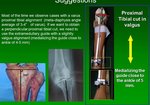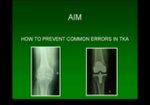Playback speed
10 seconds
Patellar Resurfacing with Freehand Resection Technique in Primary TKA
0 views
February 18, 2009
Reports have demonstrated low complications and reduced incidence of postoperative anterior knee pain when the ...
read more ↘ patella is resurfaced in primary total knee arthroplasty. This video demonstrates an easy to perform, freehand resection technique for patellar resurfacing. A limited medial parapatellar approach and measured resection technique are used in this case. The patella is gently everted and supported by the assistant with a towel clip. The thickness of the native patella is measured with a caliper. We note that the thickest part of the patella is medial to the anatomic center of the patella. The insertion of the patellar tendon and the insertion of the quadriceps tendon are identified. Resection is performed with a wide, trumpet-shaped blade from the patellar tendon insertion cephalad to the quadriceps tendon insertion. The resected bone is palpated, then recut from multiple directions to achieve a smooth, symmetrical cut. The final resection is measured with a caliper, and implant thickness selected to reconstruct to the native dimension. A sizing guide is used determine appropriate size, placement slightly medialized to reconstruct the anatomic high point and facilitate tracking, and drill holes for the 3-peg all polyethylene patellar button. The component is cemented in place and patellar tracking is assessed after tourniquet deflation.
↖ read less
read more ↘ patella is resurfaced in primary total knee arthroplasty. This video demonstrates an easy to perform, freehand resection technique for patellar resurfacing. A limited medial parapatellar approach and measured resection technique are used in this case. The patella is gently everted and supported by the assistant with a towel clip. The thickness of the native patella is measured with a caliper. We note that the thickest part of the patella is medial to the anatomic center of the patella. The insertion of the patellar tendon and the insertion of the quadriceps tendon are identified. Resection is performed with a wide, trumpet-shaped blade from the patellar tendon insertion cephalad to the quadriceps tendon insertion. The resected bone is palpated, then recut from multiple directions to achieve a smooth, symmetrical cut. The final resection is measured with a caliper, and implant thickness selected to reconstruct to the native dimension. A sizing guide is used determine appropriate size, placement slightly medialized to reconstruct the anatomic high point and facilitate tracking, and drill holes for the 3-peg all polyethylene patellar button. The component is cemented in place and patellar tracking is assessed after tourniquet deflation.
↖ read less
Comments 4
Login to view comments.
Click here to Login






















